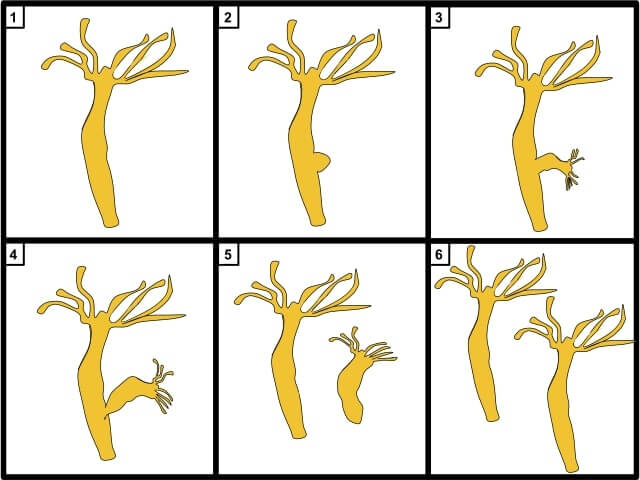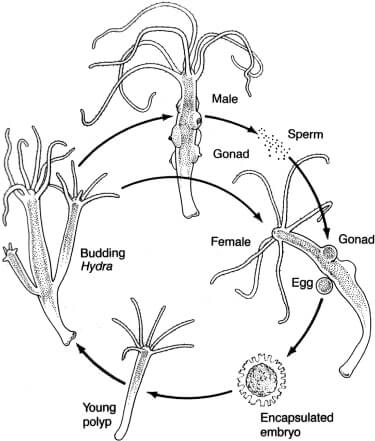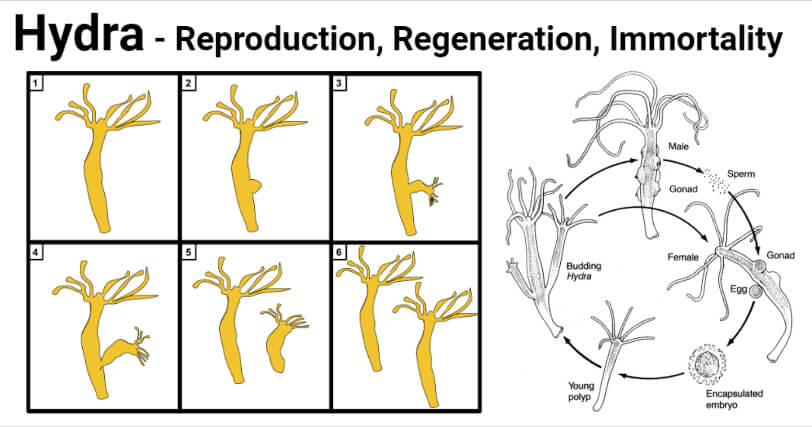Hydra reproduces asexually by budding and sexually by the formation of gametes.
Interesting Science Videos
Asexual reproduction of Hydra by Budding

Figure: Hydra Budding. 1. Non-reproducing, 2. Creating a bud, 3. Daughter growing out, 4. Beginning to cleave, 5. Daughter broken off, 6. Daughter clone of the parent. Image Source: A.houghton19 (Wikimedia).
- Budding is a form of asexual reproduction that results from the outgrowth of a part of a cell or body region, leading to a separation from the original organism into two individuals.
- Hydra reproduces asexually by budding. During the summer season, when the animal is well-fed and healthy, budding is the usual reproduction method. It occurs all time of the year.
- A bulging appears due to the repeated mitotic division of epidermal interstitial cells near the middle or in the basal part of the body.
- This grows as a bud with its wall consisting of epidermis and gastrodermis and the interior lumen in continuation with the parent’s gastrovascular cavity.
- The bud enlarges, develops a mouth and a circlet of tentacles at its free end.
- Once the bud is fully developed, it constricts as the base (point of attachment to the parent Hydra) and finally separates from the parent body to become an independent organism.
- This process may take about 3 days from start to end.
- Occasionally, several buds occur at the same time on a single parent, and these, in turn, may develop secondary buds, so that group is formed which temporarily resembles a colonial hydroid.
Hydra Asexual Reproduction (Budding) Animation
https://www.youtube.com/watch?v=d5-hPkcQDrU
Sexual reproduction in Hydra
- Hydra reproduces sexually by the fusion of gametes when the environmental condition becomes unfavorable (generally in autumn).
- Factors such as changes in temperature (low temperatures) and the lack of sufficient food sources cause the organism to start developing gonads in preparation for sexual reproduction.
- Sexual reproduction in Hydra is only limited to specific certain periods.
- For sexual reproduction, gonads develop temporarily from interstitial cells of the epidermis which accumulate to form bulges in the body.
- The bulgings of gonads differ from the bulging of buds as the mesogloea and gastrodermis do not enter into the gonads.
- Some species are hermaphrodite or monoecious ( both male and female gonads upon the same individual, e.g., H. viridissima.). Usually, testes develop towards the distal end and ovaries towards the basal end of the body.
- Most of the species are Unisexual or Dioecious ( e.g., H. oligactis), in which genders are separate.
- The male is smaller in size and bears 1 to 8 conical testes having teat-like structure over them, while the female is larger and has 1 0r 2 ovaries.
- Even in hermaphrodite species, self-fertilization is avoided, because spermatozoa and ova mature at different times. The testes mature earlier than ovaries(Protandrous condition).

Image Source: sarahinbiology.
1. Testes
- Testes or male gonads are conical elevations of the body wall, varying in number from a few to many.
- It is formed by rapidly multiplying interstitial cells of the epidermis which is covered outside by a protective capsule formed of large epidermal cells.
- They are usually located near the distal or oral end of the body, when numerous, they may cover the greater length f the body.
- The interstitial cells thus enclosed are converted into spermatocytes, each of which then divides twice to produce four spermatozoa.
- The interstitial cells at the base of the conical outgrowth (testes) act as spermatogonia. They undergo typical spermatogenesis and passing through primary, secondary, and spermatid stages to become spermatozoa or sperms.
- Each sperm has ahead containing nuclear material ( conical head), a short neck, and a wavy tail.
- When mature, sperms are discharged by the rupture of the testis wall at its apical nipple-like protuberance, thus liberated sperms swim about in the water where they remain active for a day or two.
2. Ovaries
- Ovaries are ovoid structures located near the basal end of the body.
- It develops a little later than tests.
- In green Hydra, usually, one ovary is present, while in brown Hydra as many as eight ovaries are formed.
- It is also formed by the multiplication of interstitial cells which constitute the primary oogonia.
- One of the oogonia, usually that which is centrally located, becomes larger and amoeboid, with a big nucleus called an oocyst.
- An oocyst feeds upon its smaller neighboring interstitial cells, which become yolk or reserve food, to be used up later while young Hydra is still without a mouth to feed.
- Oocyst increases in size greatly and undergoes two maturation divisions resulting in the production of 2 polar bodies and reduction of chromosomes to a haploid number which is 15 in the case of Pelmatohydra.
- The mature egg or ovum is the female germ cell which is a large spherical mass, laden with yolk granules and occupying most of the space inside an ovary.
- When an egg is ripe, the epidermis over it ruptures and withdraws to form a cup-like receptacle containing exposed egg,
- Ovum is not set free at once but remains attached to the ovarian wall.
- One ovary usually contains a single ovum, but rarely there are found 2 (Chllorohydra viridissima), oven even more (Hydra dioecia) ova.
- The ovum secretes a gelatinous substance around itself.
3. Fertilization
- Fertilization occurs when ripe sperms cells are discharged from testis swim about in water until they approach an extruded ovum and surround it.
- Several sperms may penetrate the gelatinous covering, but only one enters the ovum and fuses with it completely. This process is called fertilization, and the fertilized egg is called oosperm or Zygote.
- The male and female nuclei unite to form the fusion or zygote nucleus.
- The ovum will die and degenerates unless fertilization occurs within a short time after it is exposed.
4. Development
- The development begins soo after fertilization, while the egg or zygote still attached to the parent, by undergoing cleavage or segmentation.
a. cleavage
- As the egg has little yolk, cleavage is indeterminate, total, and equal (holoblastic), resulting in blastomeres – cells of equal size.
b. Blastulation
- The cleavage results in the production of a hollow spherical ball called the blastula or coeloblastula with a narrow cavity (blastocoel).
- Equal cells or blastomeres are arranged in a single surface layer.
c. Gastrulation
- Some cells of the blastular wall detach and migrate inwards (multipolar ingression).
- While other cells form outer and inner cells by tangential division (primary delamination). As a result, the blastocoel is completely filled by new cells, and the hollow blastula converts into a solid gastrula.
- Grastula is made of a single layer of outer cells forming ectoderm, and an inner solid mass of cells forming endoderm.
d. Encystation
- Soon a new cavity, called gastrocoel or archenteron, appears in the central solid mass of endodermal cells.
- A two-layered protective shell or cyst forms around the gastrula allowing the embryo to survive changes in the environment.
- The outer layer of the cyst wall is thick, horny, or chitinoid and spiny, while the inner layer is a thin gelatinous membrane.
- Different species of Hydra can be identified by the specific pattern of their cysts.
- The embryo remains dormant until environmental conditions improve.
- It withstands drying and freezing and carries the race through droughts and winters. It is also probable that this resting stage serves for dispersal, for it can be carried by the wind, or in mud on feet of animals to other ponds in water is present.
e. Hatching
- With the advent of the favorable conditions of water and temperature, development is resumed.
- Interstitial cells arise in the ectoderm and mesogloea is secreted in between two cellular layers.
- The embryo elongates, and a circlet of tentacles buds develops at one end with a mouth appearing in their midst.
- As the embryo increases in size, the shell or cyst ruptures, and a young Hydra with tentacles hatches out. Soon it grows into an adult.
- There are no free larval stages in the development of Hydra.
Hydra Sexual Reproduction Animation / Video Lecture

Regeneration
- Regeneration is the ability of an organism to replace its lost or damaged body parts. It usually occurs after an accident, but can be induced artificially by mutilation.
- Hydra has great power of regeneration as discovered long ago by Abraham Trembley in 1745. Since, then, Hydra has been a favorite material for experimentations on regeneration.
- If a living Hydra animal is cut into 2 or 3 or more pieces, each missing part grows and becomes a complete animal.
- A fragment of Hydra measuring 1/6 mm, or more in diameter, is capable of regenerating an entire individual.
- It is not a reproduction but a normal method of multiplication.
- Regeneration of hydras is made possible by the amazing generative powers of totipotent interstitial cells.
- One characteristic feature of regenerating piece in Hydra is that it retains polarity. The end near to mouth develops mouth and tentacles, while the end is nearer to the base form a new pedal disc.
- The parts of one Hydra may be easily grafted upon another provided they are of the same species. Grafting can be done in various arrangements producing bizarre effects.
- According to another study that was conducted at the Technion-Israel Institute of Technology in Haifa, researchers found cytoskeletons to play an important role in regeneration.
Immortality in Hydra
- P. Brien (1955) and others observed that a Hydra is at least potentially immortal due to the fact that they replace older body cells with new ones every 45 days.
- Just below the tentacles is a growth zone, where interstitial cells give rise to all other cells of the body. With the formation of new cells, the old cells are pushed towards the end of tentacles and pedal disc, from where they are shed outside.
- As older cells are shed from either pole of the Hydra, new ones continue to replace the old ones allowing Hydra to continue living for a long period of time.
- It has been shown that, if the interstitial cells of the growth zone are destroyed then the death of Hydra will be within a few days.

Image Source: A.houghton19 (Wikimedia) and sarahinbiology.
References and Sources
- Kotpal RL. 2017. Modern Text Book of Zoology- Invertebrates. 11th Edition. Rastogi Publications.
- Jordan EL and Verma PS. 2018. Invertebrate Zoology. 14th Edition. S Chand Publishing.
- https://www.studyread.com/hydra-biology/ – 6%
- https://www.farmpally.com/hydra-reproduction/ – 3%
- https://www.notesonzoology.com/gastrulation/gastrulation-meaning-activities-and-concept/2615 – 2%
- http://people.eku.edu/ritchisong/avianreproduction.html – 2%
- https://www.biologydiscussion.com/food-microbiology/low-temperature-storage-chiling-and-freezing/59275 – 1%
- https://www.notesonzoology.com/phylum-cnidaria/hydra-reproduction-and-regeneration-zoology/5807 – 1%
- https://www.toppr.com/ask/question/the-type-of-asexual-reproduction-found-in-hydra-is/ – 1%
- https://www.biologydiscussion.com/invertebrate-zoology/phylum-coelenterata/hydra-history-habitat-and-locomotion-with-diagram/28686 – <1%
- https://bio.libretexts.org/Courses/Lumen_Learning/Book-_Biology_for_Majors_II_(Lumen)/19%3A_Module_16-_The_Reproductive_System/19.22%3A_Asexual_Reproduction – <1%
- https://www.differencebetween.com/difference-between-ovum-and-vs-egg/ – <1%
